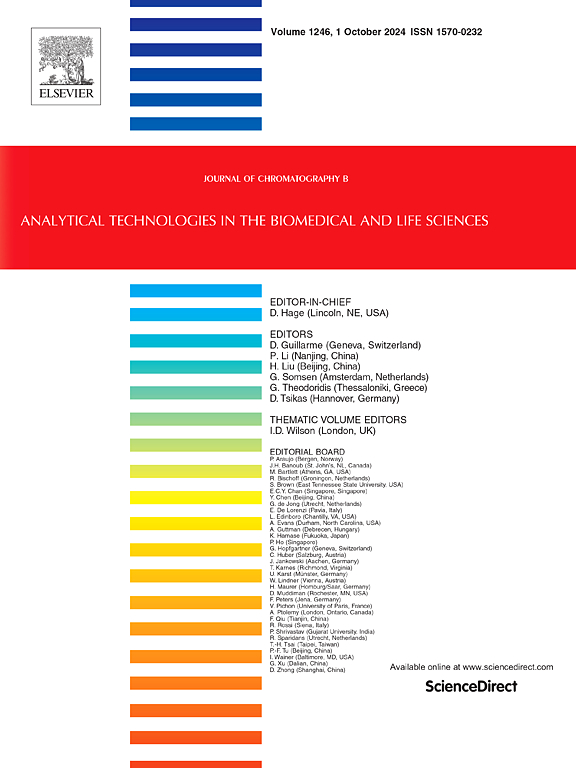A high-throughput LC-MS/MS method for simultaneous analysis of albendazole, albendazole sulfoxide and albendazole sulfone in human plasma
IF 2.8
3区 医学
Q2 BIOCHEMICAL RESEARCH METHODS
引用次数: 0
Abstract
Albendazole is a benzimidazole derivative with a broad spectrum of antihelmintic activity. Its primary metabolite, albendazole sulfoxide, is responsible for the treatment's efficacy. On the other hand, it contributes to side effects and toxicity. Therefore, their quantification in plasma may increase therapeutic success and reduce associated risks by maintaining values within the therapeutic range. The present study introduces an LC-MS/MS method for the simultaneous quantification of albendazole, albendazole sulfoxide, and albendazole sulfone in human plasma. A simple and sensitive LC-MS/MS method was developed to monitor the plasma levels of albendazole (0.25–200 ng/mL), albendazole sulfoxide (5–3500 ng/mL), and albendazole sulfone (0.5–500 ng/mL) with a coefficient of variation below 7 %. A one-step extraction procedure using an Ostro™ plate was applied, and the extracts were analysed by gradient elution followed by detection on a mass spectrometer in multiple reaction monitoring mode. The method offers several significant advantages, including a low sample volume (50 μL), a short run time (4 min), and is sufficiently linear to quantify both low and high concentrations of all analytes. The method was successfully validated according to the ICH guideline M10 on bioanalytical method validation, covering selectivity, linearity of the calibration curve, lower limit of quantification (LLOQ), accuracy, precision, dilution integrity, carry-over effect, matrix effects, extraction recovery, and stability. The fully developed and validated method was used to determine albendazole, albendazole sulfoxide, and albendazole sulfone in the plasma samples of ten patients, illustrating the monitoring of albendazole treatment in patients with alveolar echinococcosis.
hplc -MS/MS同时分析人血浆中阿苯达唑、阿苯达唑亚砜和阿苯达唑砜的方法
阿苯达唑是一种具有广谱抗虫活性的苯并咪唑衍生物。它的主要代谢物阿苯达唑亚砜是治疗效果的原因。另一方面,它也会产生副作用和毒性。因此,血浆中它们的定量可以通过保持治疗范围内的值来提高治疗成功率并降低相关风险。本研究建立了同时定量人血浆中阿苯达唑、阿苯达唑亚砜和阿苯达唑砜的LC-MS/MS方法。建立了一种简便、灵敏的hplc -MS/MS检测血浆中阿苯达唑(0.25 ~ 200ng /mL)、阿苯达唑亚砜(5 ~ 3500ng /mL)和阿苯达唑砜(0.5 ~ 500ng /mL)浓度的方法,变异系数小于7%。采用Ostro™板一步提取,提取液经梯度洗脱分析,然后在多反应监测模式下进行质谱仪检测。该方法具有几个显著的优点,包括低样本量(50 μL),运行时间短(4分钟),并且具有足够的线性,可以定量低浓度和高浓度的所有分析物。根据ICH生物分析方法验证指南M10对该方法进行了成功验证,包括选择性、校准曲线的线性、定量下限(LLOQ)、准确度、精密度、稀释完整性、携带效应、基质效应、提取回收率和稳定性。采用该方法对10例肺泡包虫病患者血浆样品中阿苯达唑、阿苯达唑亚砜和阿苯达唑砜进行检测,说明阿苯达唑治疗对肺泡包虫病的监测效果。
本文章由计算机程序翻译,如有差异,请以英文原文为准。
求助全文
约1分钟内获得全文
求助全文
来源期刊

Journal of Chromatography B
医学-分析化学
CiteScore
5.60
自引率
3.30%
发文量
306
审稿时长
44 days
期刊介绍:
The Journal of Chromatography B publishes papers on developments in separation science relevant to biology and biomedical research including both fundamental advances and applications. Analytical techniques which may be considered include the various facets of chromatography, electrophoresis and related methods, affinity and immunoaffinity-based methodologies, hyphenated and other multi-dimensional techniques, and microanalytical approaches. The journal also considers articles reporting developments in sample preparation, detection techniques including mass spectrometry, and data handling and analysis.
Developments related to preparative separations for the isolation and purification of components of biological systems may be published, including chromatographic and electrophoretic methods, affinity separations, field flow fractionation and other preparative approaches.
Applications to the analysis of biological systems and samples will be considered when the analytical science contains a significant element of novelty, e.g. a new approach to the separation of a compound, novel combination of analytical techniques, or significantly improved analytical performance.
 求助内容:
求助内容: 应助结果提醒方式:
应助结果提醒方式:


